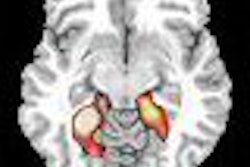
When MRI researchers began experimenting with the modality, the breast was one of the first body parts to be imaged. Twenty-six years ago, Sir Peter Mansfield and colleagues reported on the use of nuclear magnetic resonance (NMR) in breast carcinoma (British Journal of Radiology, March 1979, Vol. 52:615, pp. 242-243).
A year later, a group from Delft University in the Netherlands determined that "the similarity between the shape of a tumor in an (NMR) and in an x-ray image of a thin section of mamma tissue is quite convincing" (Philosophical Transactions of the Royal Society of London, Series B, Biological Sciences, June 25, 1980, Vol. 289:1037, pp. 535-536).
But was it convincing enough to push MRI to the forefront of breast imaging? Yes and no. On the one hand, MRI has proved itself many times over as a highly sensitive test, particularly in younger women and those with a genetic predisposition to the disease. On the other, the modality continues to suffer from poor specificity, frequent false-positive finds, and a hefty price tag.
So breast imaging experts continue to strive for improvements with MRI. At the 2005 RSNA meeting in Chicago, researchers will continue to debate the merits and drawbacks of breast MRI. Scientific papers will focus on MR spectroscopy (SSA01), breast MRI with computer-aided detection (SSM01), and MRI for staging (SST01), to name a few.
In the meantime, a series of papers at the 2005 American Society of Breast Surgeons meeting in Los Angeles summarized the inroad that MRI has made in advancing breast imaging.
MRI in dense breasts
Researchers from the Cleveland Clinic Foundation in Ohio reiterated what breast imaging experts currently know about MRI: it is unaffected by breast density, turning in high sensitivity and the ability to spot small cancers.
Dr. Heather Wright and colleagues evaluated the modality for the detection of mammographically occult cancers, particularly in premenopausal women. The group is from the clinic's departments of general surgery and radiology, as well as biostatistics and epidemiology.
This small retrospective study included 89 women with breast cancer (median age of 56) who underwent gadolinium-enhanced 1.5-tesla MRI and also had mammograms available for review. Of these patients, 20 were premenopausal at the time of diagnosis.
Malignant lesions were identified with mammography in 88% of the patients, according to the results. MRI spotted 98% of malignancies. "MRI was positive in four (6%) of the perimenopausal or postmenopausal patients, whereas in the premenopausal group, seven (35%) had negative mammogram but positive MRI results," the group wrote (American Journal of Surgery, October 2005, Vol. 29:4, pp. 572-575).
While they concluded that their results reinforced previous research, they acknowledged MRI's shortcomings and stressed that the role of the modality was still evolving.
Whole-breast staging
The current cancer staging system focuses on tumor size and nodal status of the primary tumor to predict metastasis. Wright and many of the same authors at the Cleveland Clinic Foundation have suggested that an inspection of the entire breast with MRI could yield better information about cancer prognosis.
"It is reasonable to hypothesize that increased vascular blood flow within the ipsilateral breast may be a reflection of the growth and metastatic potential of a primary breast tumor," explained Wright and co-authors. "Whole-breast vascularity as measured by MRI may represent a novel noninvasive method of providing information concerning the biologic aggressiveness of primary breast tumors" (American Journal of Surgery, October 2005, Vol. 29:4, pp. 576-579).
For this study, 22 women with unilateral, histologically proven breast carcinoma underwent gadolinium-enhanced and dynamic MRI (Harmony, Siemens Medical Solutions, Malvern, PA). The majority of these patients (20) had infiltrating carcinoma with a mean tumor diameter of 2.7 cm. In 68% of the 22 women, whole-breast vascularity was increased in the ipsilateral breast.
The authors correlated vascularity with standard prognostic factors and stated that they were surprised to find "two patients with ductal carcinoma in situ had increased ipsilateral whole-breast vascularity, although certain patients with tumors ≥ 3 (cm) did not." Of the six patients with metastatic disease in the regional lymph nodes, five had increased ipsilateral vascularity.
They concluded that malignant breast neoplasms were associated with a higher ipsilateral vascularity in a significant percentage of their patient population. They stated that they are currently conducting a second study with a larger cohort of patients.
"Additional prognostic markers are needed to identify patients with biologically aggressive disease (which) may have prognostic and therapeutic implications," they wrote.
MRI and US
A 2004 study in the Journal of the American Medical Association declared that breast MRI was still not specific enough to serve as a viable replacement for biopsy of suspicious lesions (JAMA, December 8, 2004, Vol. 292:22, pp. 2735-2742).
Fair enough, but what about using MRI-guided biopsy to take a closer look at lesions found with MR imaging? Surgeons and radiologists from Grant Medical Center in Columbus, OH, are not sold on the idea.
"MRI-guided biopsy is costly, time-consuming, and not widely available," said Dr. LeAnn Beran and colleagues. "The intent of this study was to document the ability of targeted ultrasound to identify additional lesions detected on MRI in patients with diagnosed or suspected breast cancer" (American Journal of Surgery, October 2005, Vol. 29:4, pp. 592-594).
Fifty-two patients (mean age 51 years) with suspicious lesions on MRI who required targeted ultrasound were included in this retrospective study. Breast MR images were acquired on a 1.5-tesla scanner (Symphony Quantum, Siemens Medical Solutions, Malvern, PA) using a bilateral breast coil. Lesions were considered suspicious if they showed rapid enhancement and washout patterns or irregular margins.
Seventy-five additional suspicious lesions, which were not seen on prior imaging studies, were detected on MR. Of these, 73 were evaluated with targeted ultrasound, which found 89% of these lesions. The majority of cases (32 of 73) were invasive ductal cancer.
Beran's group recommended that ultrasound be used to facilitate breast MR and determine when biopsy was appropriate or if short-interval follow-up with imaging and clinical exam was a viable option.
Reducing false positives
"(False-positive) findings are particularly problematic and significantly offset potential benefits from breast MRI. FP findings prolong patient evaluation and increase patient anxiety. They also typically lead to additional imaging studies," wrote Dr. Samantha Langer and colleagues in the introduction to their study on breast MR (American Journal of Surgery, October 2005, Vol. 190:4, pp. 633-640).
Specifically, Langer's group from Stanford University Medical Center and Stanford Cancer Center in Stanford, CA, looked at the pathologic correlates of false positives on breast MRI. Their specific goal was to define morphologic characteristics, and kinetic enhancement curves, that might more accurately predict benign disease processes.
They retrospectively reviewed the records of 110 women who underwent 144 breast MRI scans from June 1995 to March 2002. Gadolinium-enhanced MRI was performed on a 1.5-tesla scanner (EchoSpeed, GE Healthcare, Chalfont St. Giles, U.K.). High spatial resolution transfer imaging was done to collect morphologic information; dynamic 3D spiral MRI was performed to obtain delayed kinetic enhancement curves. An MRI wire-localized biopsy technique was used for surgical excision with conventional mammography done after hook-wire placement.
Of the 144 MRI scans, 32 (22%) demonstrated lesions that turned out to be false-positive findings. These patients also underwent biopsy that demonstrated benign breast tissue. In all cases, only breast MRI had identified suspicious lesions.
"Biopsies were recommended for lesions seen on MRI predominantly because of suspicious or indeterminate kinetic curves in 23 (80%) lesions, suspicious morphology in the absence of abnormal kinetic enhancement curves in two (7%) lesions, probably benign lesions associated with suspicious MRI findings elsewhere in the same scan for three (10%) lesions, and probably benign findings in the setting of a strong family history ... in one (3%) lesion," the authors explained in their results. Histologic analysis of these 29 lesions revealed variants of normal breast tissue in 20 (69%).
The authors found that false-positive lesions that measured more than 5 mm tended to be discrete benign entities, such as radial scars or prior biopsy changes.
Meanwhile, suspicious lesions on MRI measuring less than 5 mm were often associated with benign variants of breast tissue. This was true even if the MRI enhancement pattern was highly suspicious. These lesions tended to be discrete nodules of fibrocystic change surrounded by fatty tissue. Langer's group offered possible reasons for this, such as improper lesion localization, wire migration during mammography, surgical errors, improper identification by pathologists, and enhancement influenced by the menstrual cycle.
"While one could consider managing patients in this group with clinical observation and serial MRI scans instead of performing surgical biopsy, the results from this exploratory study requires validation in a larger dataset," the authors concluded. Allowing for other options besides immediate biopsy would be a step toward improving MRI's specificity in breast imaging, they added.
By Shalmali Pal
AuntMinnie.com staff writer
October 28, 2005
Related Reading
Breast MR accurately predicts tumor response to chemo in two studies, June 14, 2005
Gadobenate dimeglumine MR spots abnormal breast vascularity, cancer, June 8, 2005
MRI plus mammography best screening strategy in high-risk women, May 16, 2005
Breast MRI OK immediately following biopsy, May 3, 2005
Copyright © 2005 AuntMinnie.com



















